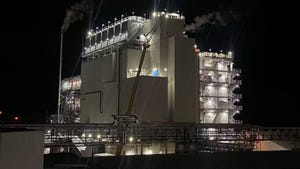Paccor add PET sheet extrusion line
Paccor International GmbH, based in Zell / Mosel in Germany and now a member of the Coveris group, has expanded its production capacity for PET sheet with the purchase of a complete three-layer coextrusion line, including an in-line lamination station, for its Polish factory in Skierniewice. The line from battenfeld-cincinnati achieves an output of 1.1 t/h and thicknesses ranging from 200 µm to 1.2 mm.
March 10, 2014
Paccor International GmbH, based in Zell / Mosel in Germany and now a member of the Coveris group, has expanded its production capacity for PET sheet with the purchase of a complete three-layer coextrusion line, including an in-line lamination station, for its Polish factory in Skierniewice. The line from battenfeld-cincinnati achieves an output of 1.1 t/h and thicknesses ranging from 200 µm to 1.2 mm. The company says that due to the in-line lamination station, multi-layer sheet are just as easy to produce as barrier sheet and sealing sheet made of different polymers and regrinds.
The new three-layer co-extrusion line has now been operation at the Polish Coveris plant in Skierniewice since August 2013. "We have once again chosen a line from our long-standing machine supplier in Bad Oeynhausen, as we are  absolutely satisfied with the energy-efficient operation and the options of manufacturing a variety of different sheet products with one extrusion line only. Another decisive argument in favor of the purchase was the high output of 1.1 t/h with a net sheet width of 900 mm, which enables us to optimally cater to the growth market of food packaging," said Marcin Antos, managing director of Coveris.
absolutely satisfied with the energy-efficient operation and the options of manufacturing a variety of different sheet products with one extrusion line only. Another decisive argument in favor of the purchase was the high output of 1.1 t/h with a net sheet width of 900 mm, which enables us to optimally cater to the growth market of food packaging," said Marcin Antos, managing director of Coveris.
The complete line includes components such as material dosing to the sheet winder and lamination unit. The co-extrusion line is able to produce three-layer PET sheet in thicknesses ranging from 200 µm to 1.2 mm. Due to an optional rotating infrared tube (or heater) for precrystallization of the material, regrinds can also be used in the middle layer without any problems, the company said.
The line includes a lamination unit in which, for example, the sheet can be provided with a barrier layer to extend the shelf life of the packaging, or with a PE sealing layer for subsequent peelability and/or weldability.
The process technology highlight of this line is the main extruder model BC 1-120-40 D WT 170, which equipped with a processing unit in which a single screw is combined with a planetary roller extruder section. The machine's design is similar to that of a standard single screw extruder, but equipped with a planetary roller zone in the degassing area. The operating principle in this area causes the melt to be spread out in very thin layers. In this way, an extremely large surface is generated, which produces excellent degassing results. This even permits the use of undried regrind material and ensures the energy-efficient operation of the entire line.
About the Author(s)
You May Also Like


